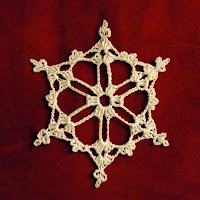So today I started work on this chevron cardigan. I chose it because it works up quickly, and as I said, I'm already cold. Also, when I looked at the project pictures on ravelry, they were all pretty cute; that gives me confidence in a pattern, when it works in anyone's hands. Also also, it says it only needs 600-800 yards of yarn, which is pretty good for a sweater.
This is the first 9 rows. The first 5 rows increase from the neck down, and after that it's a relatively straightforward chevron pattern for the remainder of the yoke. I'll get back to you after I have the yoke done.
Here's a stitch detail. I got a gift card to Michael's for Christmas, and the store was duly ransacked by holiday shopping; the yarn shelves were depleted. That meant the only sport weight yarn available was in the baby section; I was happy to find anything designed for someone over 18 mos old. This is Bernat Softee Baby in Flannel (I don't know why it's not just called grey.) The pattern suggests a size J/10 hook, and that is working nicely to match the gauge so far.
I am looking forward to seeing how this one takes shape. And then to being warm.
--Update 9.8.2012 --
Sometimes I make myself laugh. I put this sweater down for a VERY long time, and when I finally picked it back up, it took all of 3 hours to finish. At least I'll have it for the cold months this year.
I am happy with the finished product. My buttonhole is too wide, and the button stock at the craft store left something to be desired, so I couldn't find a big enough button that suited the color of the yarn. The black one I have on now will do, but I will likely change it out.
In the meantime, enjoy these pictures of the finished sweater:
 | |||
| Add From the front. The shoulders aren't actually all that football gear-ish. I just have on an inappropriate undershirt. |
 | ||
| From the rear. I shall be more careful to untwist my sleeves in future. | I like the texture of this sweater a lot. |
 |
| Detail of the closure and its abnormally large buttonhole. |
































